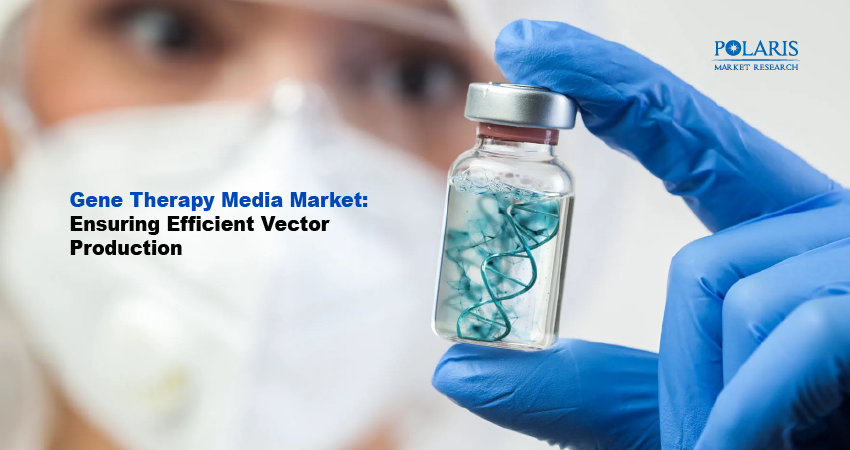Gene Therapy Media Market: Ensuring Efficient Vector Production

Fixing or replacing faulty genes to treat diseases once seemed like a feat that was very hard to achieve. But gene therapy has now made it a real medical solution. Of course, there are several elements that are essential for gene therapy to work. And one of them is gene therapy media.
Gene therapy media offers the perfect environment for cells to develop and be modified for therapy. In this blog post, we explain to you the fundamentals of gene therapy media. We also cover the key metrics for the gene therapy media market and what’s driving it forward. Keep reading!
Understanding Gene Therapy Media
Gene therapy media is essentially a liquid that’s full of nutrients. It helps cells grow and function properly during the development of gene therapy. These cells are needed to produce viral vectors or other carriers to deliver therapeutic genes to patients.
Think of it as a cell environment in a bottle. Humans need energy sources and the right conditions to live. Similarly, cells need a precise mix of various nutrients. Cell therapy media enables the development of a controlled setting in which the results of cells are consistent.
Media Importance in Gene Therapy
Precision needed to be taken care of in the gene therapy market. The media composition can have a direct influence on the growth of cells and how efficiently they are able to produce therapeutic vectors. It also impacts the safety and effectiveness of the final therapy. Even small changes in media formulation can affect quality and yield.
Take, for instance, that the media doesn’t have essential nutrients. This may result in poor growth of the cells and reduce the production of viral vectors. The presence of impurities can result in contamination risks. As such, media design is very important for gene therapy. Scientists and biotechnologists give a large amount of time to fine-tuning formulations to make sure they offer high-performance results.
Gene Therapy Media Market Metrics
Our analysis reveals the gene therapy media market is expected to witness sustained growth in the years to come. The market stood at USD 408.06 million in 2024. It is expected to account for a CAGR of 17.27% from 2025 to 2034.
Several factors are driving the growth of the market. First, there has been a rising incidence of rare and long-term conditions. This has resulted in increased demand for gene therapy targeted at specific genes. The expansion of cell and gene therapy manufacturing units globally is also contributing to the gene therapy media market expansion.
Main Components of Gene Therapy Media
Basal Nutrients
Basal nutrients are an essential part of cell culture media. These nutrients include glucose, amino acids, and vitamins, amongst others. They serve as the food source for cells. They help cells grow and produce therapeutic proteins. Having the right balance of cells is needed. This is because even small changes can affect the growth rate of cells and their vector production rate.
Growth Factors and Hormones
There are growth factors and hormones present in gene therapy media. These molecules recreate the natural environment of the body. They signal cells to grow or perform specific actions. In gene therapy, these molecules boost the growth of host cells for higher vector yields. Growth factors and hormones also improve the efficiency of gene delivery.
Buffers and pH Stabilizers
A stable pH is needed for the metabolism of cells. Even small changes in pH can harm cells. To prevent this, buffers are present in the media that resist the build-up of acid caused by cellular waste. These buffers make sure that there’s a balanced environment where cells can thrive.
Media Types Used in Gene Therapy
Growth Media
Growth media is a starting point of any gene therapy workflow. Gene therapy involves modifying or using cells to produce vectors. But before that, the cells must be healthy and be available in large numbers. Growth media is designed to support the steady growth of cells. It also keeps the cells stable and stress-free. There are typically higher levels of nutrients in growth media. These nutrients help cells reach the right density.
Transfection or Transduction Media
After the cells are ready, the next step involves the introduction of new genetic material. This can be achieved through transfection or transduction. This media is created to improve the uptake of DNA or viral vectors. It helps reduce the stress during gene delivery. It also makes sure that the right conditions are there for the gene to enter the cells. The possibility of serum interfering with transfection reagents means the media typically has low or no serum.
Production Media
Once cells receive the new genetic material, they start the production of the final therapeutic product. This product is often a part of the viral vector manufacturing market, such as AAV or lentivirus. Production media is optimized to boost vector yield and maintain high product quality. It also reduces the stress on cells when the metabolic activity is intense. Production media are usually chemically defined to meet clinical standards.
Harvest and Maintenance Media
After the production of viral vectors, they need to be kept stable until their collection is done for purification. Haverst and maintenance media help in preserving cells and vectors during this period. These media work to slow down the activity of cells to avoid unwanted degradation. Harvest and maintenance media keep cells alive for a long period to ensure efficient harvesting.
Conclusion
Gene therapy is an exciting area of modern science. It is providing treatment options for diseases that were once thought impossible to cure. Gene therapy media is something that makes every successful treatment possible. As we move forward, we can expect to see gene therapy media market players making improvements in media to make gene therapies more effective.

